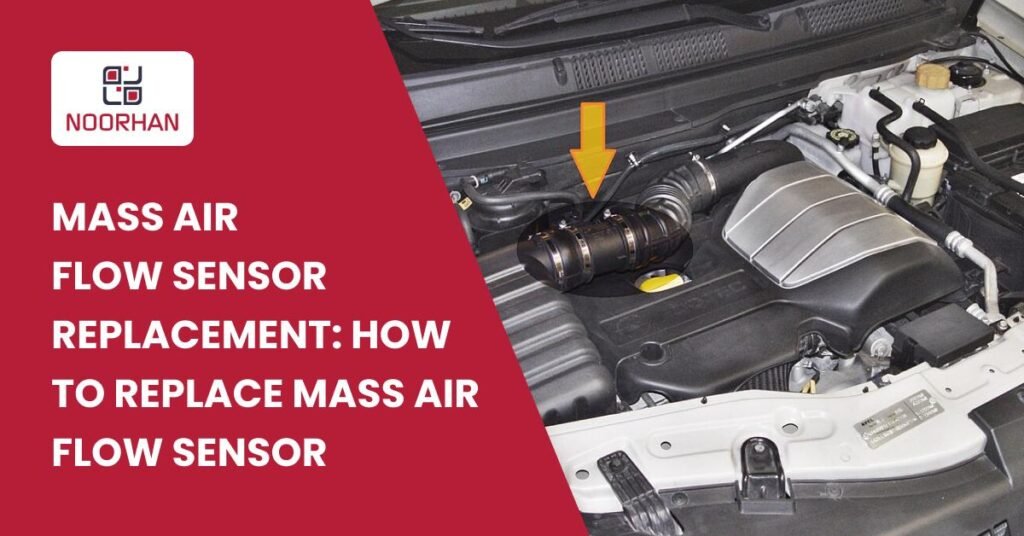Mass Air Flow Sensor Replacement: How To Replace Mass Air Flow Sensor
Is your engine losing power, stalling, or getting poor gas mileage lately? A malfunctioning mass air flow (MAF) sensor may be to blame. This critical engine management component monitors the air entering your engine to improve performance.
Let’s take a look at the most prevalent symptoms of a failed mass air flow sensor, as well as some easy steps to replace a faulty mass air flow sensor.
What is a mass air flow sensor?
A mass air flow sensor is frequently referred to as an air meter. It has a critical purpose in your car. It monitors the amount of air (mass flow) that enters the internal combustion engine.
Based on these real-time inputs, the engine control unit calculates the quantity of fuel mass required to maintain air-fuel balance
How does a mass air flow sensor work in an engine
The hot-wire mass air flow sensor type is widely used in vehicles. The hot wire method uses an electrically heated wire to measure the quantity of air flow entering the internal combustion engine. A temperature sensor is positioned near the wire to measure the temperature of the flowing air. At idle, only a small amount of air travels across the wire, necessitating little electrical current to maintain its heat. When the throttle is opened, more air rushes over the wire, chilling it and necessitating more electrical current to bring it back up to temperature.
A sensor measures the electrical current and converts it to the amount of air passing through the throttle body and into the engine. An electronic chip turns the electrical current into a digital signal that the ECU may use to control the fuel injectors and ignition timing. These signals can be used to change a variety of engine settings, including the air-fuel ratio and transmission shift points.
Signs of a bad mass air flow sensor
Over time, your mass air flow sensor may wear out and fail. This is due to its continual exposure to flowing air that contains exhaust fumes, debris, and dust. Even being too unclean might cause it to stop working, so if you detect any of the following signs in your vehicle’s performance, consult a professional repair:
Check Engine Light
The most common indicator of mass air flow sensor failure is a bright check engine light. If the light comes on, regardless of whether there are any other indicators of a problem, you should take your car to your local mechanic shop. It could indicate a damaged or malfunctioning mass air flow sensor.
Stalling or hesitation
A faulty MAF sensor might cause your engine to stall or hesitate when accelerating. This is because the wrong air-fuel mixture interferes with the combustion process.
Misfiring / Rough Running
A defective MAF sensor can cause an engine to misfire, resulting in power loss and harsh running. The improper air-fuel combination might cause incomplete combustion in the cylinders.
Rough Idling
If your car’s engine idles coarsely or inconsistently, it could indicate a defective MAF sensor. Irregular air flow data can interfere with the engine’s idle speed regulation.
Black Exhaust Smoke
If your car emits a lot of exhaust smoke, something is likely at fault. While it could be due to a variety of faults, your mass air flow sensor may be damaged, causing the engine control model to calculate incorrect fuel injection, resulting in black smoke.
Poor fuel economy
The MAF sensor is critical to ensuring that the engine’s air-fuel mixture is correct. When it malfunctions, the air-fuel ratio becomes uneven, resulting in lower fuel efficiency. If you observe a sudden decline in your vehicle’s fuel efficiency, it could be caused by a defective MAF sensor.
Trouble starting
Difficulty starting your automobile can also indicate a malfunctioning MAF sensor. The proper air flow mixture should be delivered to the car at the perfect time to start it smoothly. So, if the automobile does not receive the necessary airflow, it will be unable to start, and you will confront difficult starting conditions.
How to replace a mass air flow sensor
To replace a mass air flow sensor, you’ll need the necessary tools and understanding of your vehicle’s exhaust system. The approach for your particular vehicle may differ. However, replacing the MAF usually entails the following processes
- You need to have safety glasses on
- You can find the MAF sensor located between the throttle body and the air filter assembly
- Now disconnect the electric connector from the MAF sensor
- Take a screwdriver to unscrew the clamps connected to the air intake duct
- Now gently remove the MAF sensor
- Take your time to make sure that the new sensor has the same design as the old sensor
- Now install the new sensor and tighten the clamps on the air duct
- Reconnect the MAF electrical connector.
After the replacement is complete, make sure to take your car for a test drive to check everything is working properly.
What to do after replacing a mass air flow sensor
These methods can help you resolve the majority of issues that arise after installing a new MAF sensor; nevertheless, use them with caution.
1. Unplug the sensor
Turn off the engine, remove the keys from the ignition, and allow the engine to cool. Consult your owner’s handbook to determine the location of the mass air flow sensor. Unplug the component from the vehicle’s electrical system.
2. Remove the sensor
Unplug the sensor and release any clamps or brackets that keep it in place. Slide the sensor assembly away from the tubing and gently remove it from the air intake boot(s).
3. Clean the sensor
Place the sensor on a towel to clean. Apply the cleanser — 10-15 blasts around the interior of the sensor will suffice. Also, clean the part’s edges, housing, connectors, and terminals. If you have a hot wire mass air flow sensor, make sure the cleaner does not contact the hot wires or plate.
4. Reattach the sensor
Let the sensor dry. This should take just a few seconds. Once the part is ready, reinstall it, replace the clamps/brackets, and tighten them. After you’ve reinstalled the sensor, wait a few minutes before starting the car to ensure the cleaning chemicals have evaporated.
Conclusion
The Mass Air Flow Sensor is a critical component of the engine management system that monitors the amount of air entering the engine. A defective Mass Air Flow Sensor can create a range of symptoms and difficulties in the vehicle, thus it should be replaced as soon as possible to avoid further damage. Regular maintenance and good driving habits might help to extend the life of the sensor.
fAQS
It is not suggested to drive with a malfunctioning Mass Air Flow Sensor since it might damage the engine and other systems in the vehicle, resulting in costly repairs in the future.
Follow these suggestions to extend the life of your Mass Air Flow Sensor.
- maintain a clean engine
- avoid driving on dusty roads
- use high-quality fuel
- avoid driving in harsh conditions
- Also, change the air filter regularly
A defective Mass Air Flow Sensor can interfere with other systems in the vehicle, including the engine control unit, fuel system, and exhaust system. It can reduce performance, increase emissions, and perhaps harm the catalytic converter.
Yes, you can drive with a faulty MAF sensor for a limited time. It is usually advisable to repair the faulty sensor to avoid long-term engine troubles.
Mass air flow sensors are designed to last the entire life of your vehicle. There is no set replacement interval for the MAF sensor. As a result, sensors are often not replaced until they fail. However, it is usually recommended to replace the MAF sensor after 10,000 to 12,000 miles.
After installing the new MAF, disconnect the battery for 10 to 15 minutes to allow the engine or vehicle computer to forget the previously learned parameters, and then idle the engine for 20-30 minutes to avoid rough driving.
Yes, reset the ECU after replacing the MAF sensor. This is because the ECU has to relearn the air/fuel mixture. To reset the ECU, disconnect the battery for 30 minutes to an hour.



























































